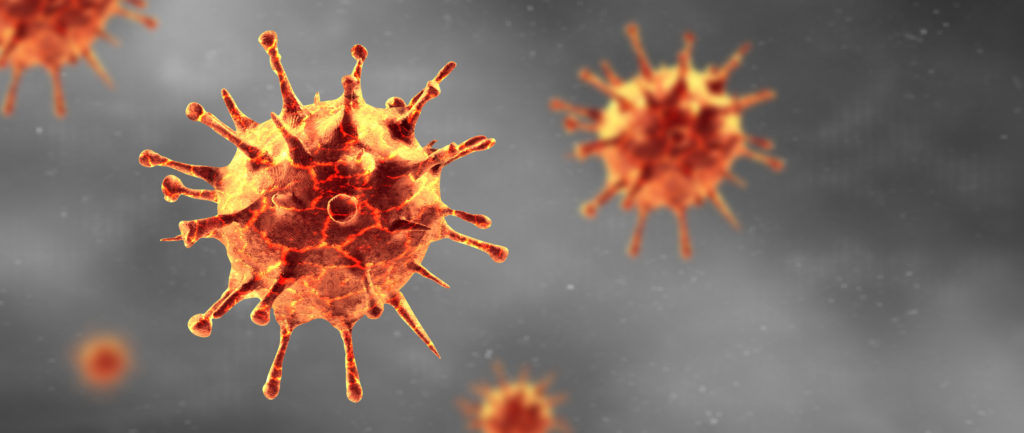The Ins and Outs of Coronavirus: Expert Advice to Protect Yourself and Others During the Pandemic
Rumya SundaramApril 27, 2020

The novel coronavirus (Adobe)
With the world in the grip of the COVID-19 pandemic, information and ideas are being thrown around without all the necessary context. That leads to numerous questions. What is a coronavirus? What is COVID-19? Who is most vulnerable and why? How can you protect yourself?
The spread of misinformation and inaccurate news is a continuing problem, so deciding which information to believe can be tricky. Key News is offering expert answers to help you protect yourself and others.
What are coronaviruses?
Coronaviruses get their name from their appearance. The virus is a sphere with spikes protruding all around, giving it a crown-like appearance. Corona means crown, hence the name.
The spikes aren’t just for looks – they are designed to attack cells via the cells’ receptors. The novel coronavirus (novel meaning new) attacks the cell-surface receptor angiotensin-converting enzyme 2 (ACE2). Ordinarily, the ACE2 receptor is used by the body for regulating blood pressure; however, the novel coronavirus can use it as an opening to attack and enter a cell.
When the virus is inhaled by an uninfected human, it can take hold because the lining of the nose and other areas of the respiratory system are rich in ACE2 receptors.
Despite the pandemic being referred to as “coronavirus,” the moniker is not very precise. According to the National Foundation for Infectious Diseases, coronaviruses are a large group of viruses that can be found to infect both humans and animals.
In humans, many common colds are caused by coronaviruses. These are usually mild but can become severe, especially in patients with underlying conditions or who are immunocompromised.
The novel coronavirus, which as of this writing has infected 2.79 million people, is known specifically as SARS-CoV-2. The virus is previously unknown to humans, and we therefore can have trouble fighting it. Despite being closely related to other coronaviruses, having had a cold or some other illness caused by another coronavirus will not give a patient immunity to the SARS-CoV-2 virus.
Though not unheard of, it is rare for a coronavirus to jump from an animal to a human. Previous epidemic or pandemic outbreaks from coronaviruses include Severe Acute Respiratory Syndrome (SARS) in 2003-04 and Middle East Respiratory Syndrome (MERS) in 2012. SARS was likely transmitted indirectly from bats through an intermediate animal to humans. MERS was traced from camels to humans.
What is COVID-19?
COVID-19 is the abbreviation for Coronavirus Disease 2019, which is the illness caused by SARS-CoV-2. The disease can cause severe respiratory distress and organ damage, among other things.
To be clear, this disease is not the flu. The symptoms are quite different, and the fatality rate is much higher. According to the Centers for Disease Control (CDC), the 2018-2019 flu season in the United States saw approximately 35.5 million people infected and 34,200 deaths. This is a fatality rate of about 0.096%. Meanwhile, the current COVID-19 infections in the United States stand at about 927,000 infected and 54,400 deaths. This is a fatality rate of about 5.9%. If the 2018-2019 flu season had the same rate, then the United States would have had close to 2 million flu-related deaths.
Most viruses will cause either upper respiratory infections, which tend to be less severe and are easier to transmit; or lower respiratory infections, which tend to be more severe but harder to transmit. SARS-CoV-2 appears to infect both the upper and lower respiratory system, making it both severe and easy to transmit.
Should you worry about your pets?
Since coronaviruses are found in both humans and animals, there has been speculation as to whether pets can carry and transmit SARS-CoV-2.
There have been a few cases of animals being infected with the novel coronavirus, including tigers and lions at the Bronx Zoo; and more recently two pet cats in New York. In China, dogs have occasionally been tested with a weak-positive result.
However, a large-scale study recently indicated that while dogs can carry the virus, they are not susceptible to infection or transmission. Other animals such as ducks and pigs are not likely to catch the virus. Cats are a different story. They may develop symptoms such as dry cough and respiratory issues, and kittens had severe reactions including large lesions in the lungs.
Cats have been shown to catch the virus from people (the big cats at the Bronx Zoo caught it from an asymptomatic zookeeper) and can transmit it to other cats, but do not appear to transmit it to humans.
In other words, there is no reason to get rid of a pet due to coronavirus fears.
Who is most vulnerable and why?
As the virus attacks the cells in the lungs, the cells begin to die. This causes the lungs to fill with dead cells and fluid, causing difficulty breathing.
As the body attacks the virus, patients experience inflammation and fever. Many patients, especially older individuals, may experience a cytokine storm. This is when the body reacts so heavily to the presence of the virus that the effects are detrimental to the patient.
Essentially, the body releases proteins (certain types of cytokines associated with immune responses) from the blood to fight the infection, but then releases so many that the blood vessels become too leaky. This in turn causes more fluid to enter the lungs and exacerbates the inflammation and breathing problems. The excess cytokines may also attack other parts of the body.
This is one of the reasons COVID-19 has a death rate between 10-15% in people over age 65. Younger patients, especially children, are less likely to experience cytokine storms, though they may still be susceptible for other underlying medical reasons such as diabetes.
According to the CDC, the main symptoms of COVID-19 are tiredness, fever and dry cough. Other symptoms to watch for include muscle pain, headache, shortness of breath, chills and loss of taste and smell. More recent research has found other strange and dangerous reactions, though many are still unconfirmed. One, referred to as “Covid Toes,” is the appearance of dermatological lesions on the feet of generally younger patients who are either asymptomatic or too early to show symptoms.
Another is the possibility of stroke in patients under 50, which is highly atypical as stroke patients typically have a median age of 74. Many physicians are also seeing organ damage in severe COVID-19 patients, such a heart inflammation, kidney disease, intestinal damage and liver issues. The organ damage may be caused by the virus attacking ACE2 receptors throughout the body, but the cause is still uncertain at this time.
Why is COVID-19 spreading so easily?
Another interesting and dangerous aspect of the COVID-19 pandemic in comparison to the MERS and SARS outbreaks is the difference in transmission rate.
Both MERS and SARS have a fairly low transmission rate. One would have to come in very close, sustained contact with an infected person to become infected. Their low transmissibility made MERS and SARS more easily contained, keeping deaths relatively low even though MERS has a fatality rate of 30-40% and SARS approximately 10%.
COVID-19 has a lower fatality rate, but it is much more easily transmitted. This is in part due to the shape of its spikes helping it stick to cells more strongly than other coronaviruses. The stronger bond means it requires less of the virus to cause infection.
This higher transmissibility makes it increasingly dangerous as more people become infected. Already, the number of deaths from COVID-19 far exceeds those from either MERS or SARS.
Below is a diagram of a study published by the CDC in which contact tracing on an asymptomatic individual showed the person (A1) had infected several other people in a restaurant setting through the water droplets they expelled, which were then carried around the room by the air conditioning.
Person A1 had no symptoms at the time they visited the restaurant. By the next day symptoms had appeared, and person A1 tested positive. In the following weeks other patrons of the restaurant also began feeling symptoms and ultimately tested positive.

How can you protect yourself?
At this point, we have all heard about the importance of social distancing, wearing a mask and washing your hands. But why do these measures work?
When an infected person coughs or sneezes, they expel water droplets carrying the virus into the air. Six feet is the minimum amount of space recommended by the CDC to maintain safety by social distancing. However, studies show droplets propelled by a cough or sneeze can travel further – even over 20 feet!
These droplets can stay suspended for several minutes to hours, and another person who is nearby or who walks into them can become infected.
As recommended by the CDC, wearing a mask, even a homemade cloth mask, can help.
If you are infected, as you breathe, cough or sneeze the mask can help reduce the amount of water droplets you expel into the air around you. Though it will not prevent all of it, it will significantly lessen the spray.
If you are not infected, wearing a mask will help reduce your chance of inhaling any lingering water droplets from someone who is infected. Again, it will not bring your chance of infection to zero, but it will greatly diminish it.
Finally, washing your hands frequently is necessary. SARS-CoV-2 can linger on surfaces for hours to days. As you interact with others and spend time in public areas, you may touch surfaces contaminated by the virus. The virus body is made up of lipids (fatty acids), which are easily disrupted by soap and disinfectant. While these disinfectants are poisonous within the human body, washing your hands and cleaning surfaces frequently will help keep the virus at bay.
Another good way to escape infection is to avoid touching your face after touching frequently used surfaces.
The bottom line…
A good rule is to behave as though you are already carrying the virus and you are trying to avoid infecting others. Strict social distancing will remain necessary for some time to come, but the harder we work at it, eventually the less it will be necessary.
In short, to prevent the virus from infecting more people, as a community we must act appropriately and we must act together.


